This piece is co-written by Gretchen and Kylie
It’s hard to find a podcast or analysis piece on this site that doesn’t somehow sing the praises of Nickelodeon’s Legend of Korra. Yet with two of the three Turf Wars comics published and the third scheduled for this summer, the reaction from our Fandomentals staff, and Korra fandom at large has been, shall we say, mixed. One of the more prominent criticisms, especially after Part 2, has been Korra’s characterization and personality. It’s…definitely something, but not something we recognize as lining up with where she ended her arc in the TV series. Korra of Turf Wars seems to lack the balance Book 4 was named after, which her character had been progressing toward from the beginning.
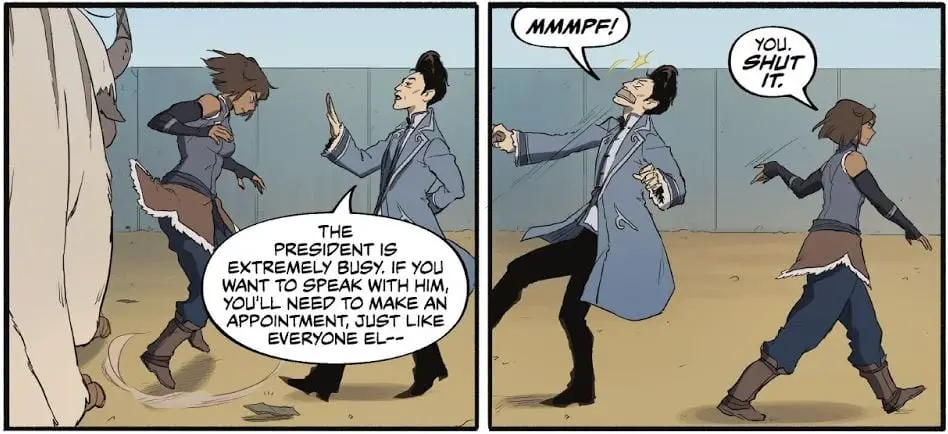
We’re still scratching our heads with how she got here. Because the last we remember from the show, Korra was identifying with the season’s antagonist and actively pursuing ways to understand how all of her enemies have been right to a certain degree, only out of balance. With that in mind, and in preparation for our Korrasami panel at ClexaCon coming up, Kylie and Gretchen decided to take a dive back into Legend of Korra and focus specifically on Korra’s healing arc in Book 4.
Out of the Compound, Into the Wringer
Korra hasn’t exactly had an easy time of being the Avatar. Not that Aang did, by any means. He was frozen for 100 years and woke up to discover that his entire culture and nation had been completely wiped out. He was a survivor of genocide facing down the imperial ambitions of the nation that had destroyed his own. He died and lost his connection to the Avatar spirit. Even after Katara revived him, his access to the Avatar state was severed, and he had to pursue spiritual healing to overcome the block.
Korra may not have to cope with being a child soldier or the genocide of her people, but that doesn’t mean she didn’t experience trauma. It’s just a different kind. Korra’s traumas were far more personal than Aang’s, and by that, we mean specific to her person—localized in her body and her bending. In Book 1, as soon as she sees Amon remove a Triad leader’s bending, that becomes her greatest fear, only for her to suffer that later. She loses her water, fire, and earth bending. It’s a terrifying moment for her, but her concern for saving Mako from the same fate unlocks her airbending ability. Still, she’s traumatized, depressed, and seemingly on the verge of committing suicide…

Until Aang shows up and magically restores her other bending abilities as well as giving her the power to restore everyone else’s, too. Yay! She’s fixed now!
So far as Book 2 is concerned, what even are depression and the lingering effects of trauma? Korra sure doesn’t know, because her losing her bending is never explored in any meaningful way, or even brought up. She has her bending back, so why dwell?
But Book 2 presents her with yet another personal, traumatic loss in the form of having Raava literally ripped out of her and her past lives destroyed. In two seasons she’s arguably lost two of the most important pieces of herself that make her who she is as the Avatar: her bending and Raava. And unlike Aang, it isn’t that she just lost contact with the Avatar spirit or couldn’t enter the Avatar state. She literally had the Avatar spirit—who must feel like a second soul inside of her given how deep and intimate the connection is based on what we see with Raava and Wan—forcibly torn out of her and shattered.
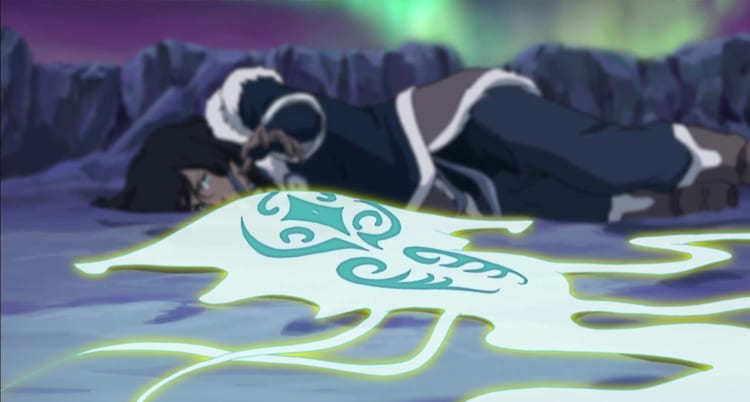
Thankfully, when she’s reunited with Raava, it’s less a ‘lol, fixed’ than the ending to Book 1 was, though it was still not quite what one would expect for such a painful event. She’s ‘whole’ again as the Avatar, although she still lost her past lives. All that history, wisdom, knowledge, and experience: gone.
And it isn’t just that, she’s lost a community, a sense of her own place in the world. We see in Books 3-4 that she struggles to make her way in the world precisely because she lacks this sense of place. What must be a lonely experience—being the only one of your kind and misunderstood or rejected because of your power—was mitigated knowing she was one of a long line of Avatars. She could take comfort in their presence in her ‘life’ even if she didn’t commune with them. Just knowing they were a part of her through Raava meant she wasn’t alone.
In one stroke, she lost all of that.
However, losing her past lives wasn’t really presented as having been traumatizing. On paper, this sounds like a very damaging thing to have happen, yet it’s presented more as an inconvenience since she now cannot access them as a resource. One would think at least the show would have explored how traumatizing it would be for Katara and the Gaang kids to ‘lose’ their dad all over again. But no, losing her past lives is just a thing that happens and Korra has to seek advice from real human beings instead of asking the former Avatars.
Bolin: Ooh sorry, did I interrupt an Avatar wisdom session?
Korra: Avatar wisdom is the thing of the past, Bolin.
That’s not inherently a bad move. We really like Korra connecting to and seeking advice from Toph, Tenzin, Lin, Suyin (er…sometimes), and Asami. At the same time, not treating the loss of the Avatar spirit or her past lives as traumatic does feel inauthentic and like a missed opportunity.
That brings us to the events of Book 3, where Legend of Korra sets up what will be one of the most compelling healing arcs we’ve ever seen. And that’s saying something for a show that didn’t actively deal with the protagonist’s trauma for half of the show’s run.
After being pursued for unclear reasons by a group of anarchists with unclear motivations all season, Korra is ultimately poisoned by their leader Zaheer with a metallic poison in an attempt to force her into the Avatar state and kill her, ending the Avatar cycle for good. While she’s under the influence of the poison in the Avatar state, Zaheer tries to suffocate her. When the poison is (mostly) removed, we can see clearly that Korra isn’t the same. She survives, but only at great cost to herself physically, mentally, and emotionally.
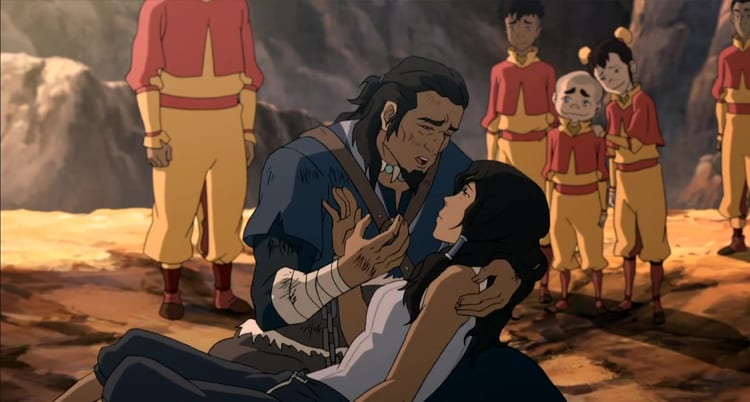
Unlike the previous two trauma’s Korra suffered, this one was intentionally written to be lasting so that the show could explore it in Book 4. Even the ending to Book 3 wasn’t as neat as the previous two books. Where Book 1 closed with a magical Aang fix and Book 2, with a fully whole and restored Avatar, Book 3 breaks with the pattern and offers us a ‘flash forward’ to three weeks later…and Korra still isn’t healed. She’s in a wheelchair and visibly depressed. We know right then that the story isn’t going to take the easy road out of Korra’s traumatic experience with Zaheer.
Before we talk about the healing arc proper there’s one other thing to note about Korra’s arc in Books 3-4, and that is what it displays about showrunners’ Bryan Konietzko’s and Michael DiMartino’s (aka Bryke) growth as storytellers. Legend of Korra is actually a great test case to talk about writers actively improving over the course of the show. They listened to their audience and course corrected, and they listened to their characters and the chemistry—we have that instinct to thank for Korrasami (more on that later).
And, they also display a desire to improve and ‘get it right’ when it comes to dealing with Korra’s trauma. As we’ll see, Book 4 doesn’t just deal with Korra’s trauma from Book 3; it also finds ways to include and explore what she experienced in Books 1-2. With Book 4, we truly get to see Bryke give Korra space to deal with her suffering in a meaningful way. And that’s a huge mark of growth from “yippee, Aang fixed Korra’s depression!” in Book 1.
“Nobody expects you to bounce back right away”
Perhaps the most interesting call was that Book 4’s opening episode was almost entirely Korra-free, until the final scene. We learned through the other characters that she had been at the South Pole for the three years that passed, and everyone was eagerly awaiting her return to Republic City. However when Tonraq arrives without her, it’s quickly discovered that she gave all her friends and family the slip for the past 6 months. When we find out where she is, it’s nearly as grim as where we left her the previous season: underground fighting (and losing) somewhere in the Earth Kingdom, while denying that she’s the Avatar. This was tonally striking and foreboding, and sort of allowed the audience to immediately tap into Korra’s interpersonal imbalance.
That’s what’s great about this arc is that from the get-go: it’s clear that her regaining physical strength is not the sum total, nor even really the focal point. Book 3 ended with her in a wheelchair, yet our first glimpse of her in Book 4 in the earthbending fight is just as worrying, if not more so. It’s clear she’s made an unhealthy choice to hide, and is not in the best state of mind. Even her loss in the match seemed more as a result of that headspace rather than any physical limitations.

It’s the next episode where we get the details. “Korra Alone”—named after “Zuko Alone”, which is considered one of the best episodes from Avatar: The Last Airbender—is a nonlinear tale of Korra’s recovery up until the unground fight. We learn through flashbacks that soon after the end of Book 3, she traveled back to the Southern Water Tribe alone in order to heal. There, she struggled with nightmares, clearly not improving for what might have been months (based on her friends’ letters piling up), until her mom begged her to visit Katara.
We then get a sequence of healing sessions: Korra wiggling her big toe for the first time, Korra taking her first assisted steps. These also include Korra screaming in frustration at Katara thanks to her slow progress. It’s then that Katara talks about Aang’s own struggles with the loss of his culture, and how he choose to find meaning in his suffering and recontextualize what he had gone through.
Katara: [Aang] chose to find meaning in his suffering and eventually…found peace.
Korra: And, what am I going to find if I…get through this?
Katara: I don’t know. But won’t it be interesting to find out? (4×02)
The next flashbacks take us to a Korra that’s sparring with the White Lotus again, trying to show-off for a visiting Tenzin like she does in Book 1. However, she’s clearly not in the fighting shape she used to be, and when she loses, she expresses her frustration at not improving fast enough. We next get her narration of a letter she writes to Asami two years after her injury, intercut with scenes of her training and meditating. She confides that she hasn’t been able to get back into the Avatar state since Zaheer, and worries she’ll never fully recover.
After this, Korra tells her parents she wants to go back to Republic City to be “where the action is”, saying she hit a wall with her progress. They agree to let her travel alone, which she opts to do by boat as a way to clear her head. However, when she stops in a small village for lunch, she’s unable to apprehend two thieves in what should have been a stupidly easy fight. Worse still, as she approaches Republic City, she sees something disturbing: herself, wrapped up in platinum chains and in the Avatar state, as she had been when fighting Zaheer (from here on denoted as “dark!Korra”).

Korra decides she’s not ready to go back, cuts her hair, and changes her clothes to disguise herself. We then find out how she spent those missing 6 months, as she narrates a letter of her lying to her father; she searched for Raava, unable to feel her Avatar spirit anymore, in what looked to be the most remote reaches of the world. Even going to the Tree of Time in the Spirit World didn’t help.
We’re then taken back to the present day—just after the underground earthbending fight—which we learn she only entered because she spotted dark!Korra in the pit. She heals her bruises and leaves, only to have a cute potato-esque spirit lure her into the swamp. There, she encounters dark!Korra once again, who fights her, seemingly dragging her into a puddle of the same metal poison. Instead, she winds up in a cave where she meets Toph, who has been living in the swamp for years.
At first, Korra asks Toph to train her, since she’s getting beat-up by “losers” all over the Earth Kingdom. Yet it becomes apparent that there’s something else at play than physical shape: Korra is doubting all her old instincts. In one sequence when she wanders off in the swamp, she spots all of her past enemies in the moments where they hurt her the most. Amon taking away her bending, Unalaq ripping Raava out of her, and of course a shot of Zaheer all flash before her, and us.
We also learn that Korra’s begun to wonder if she’s even needed in the world at all (which is not particularly aided by Toph’s words on the subject). Toph is still able to get to the root of things though, and eventually explains to her that the problem is that she’s been disconnected from herself and the people she loves for too long. Oh, also, there’s still bits of metal poison inside of her, because Suyin apparently missed some when she had extracted it.
Korra asks Toph to bend it out of her, but every time she tries, Korra flashes to her fight with Zaheer or dark!Korra in some way, fighting and interrupting the process. Toph tells her she has to do it herself, and it won’t be possible if she keeps carrying around her former battles without trying to learn something from them. Korra’s disconnect from the people she cared about had been a major issue too; once she reaches out and spirit bends through the vines of the swamp, she directs Jinora, Ikki, and Meelo to her. After she reunites with them, she successfully manages to bend the metal out and re-enter the Avatar state.
It would have been easy for her healing arc to stop there. The metal was out of her, the physical reason she hadn’t been in the Avatar state and she had been losing fights. Right?
Well, the next couple of episodes counter that idea. In them, Korra tries to end the new crisis with Kuvira’s power grab by confronting her forces at Zaofu. She didn’t want to fight—that was something she felt the “old me” would have done. But when Kuvira (and Suyin, honestly) left no other way to solve the conflict, Korra agreed to duel Kuvira. She began losing, then jumped into the Avatar state, which would have clearly allowed her a finishing blow. But she still flashed to dark!Korra, causing her to fail, and Kuvira to capture Zaofu. Korra was taken to safety before Kuvira could hurt her, but she remained confused as to why she had these flashbacks now that the metal had been removed.
Once back in Republic City, Korra reconnects with her friends, getting past the awkwardness of having cut them off for three years, and even reaches out with her spirit bending to locate someone who’s missing, showing that she she can stay connected outside of the swamp. She still worries about whether the world needs her, but when the city’s spirit vines go haywire and kidnap a group of tourists thanks to Kuvira’s meddling with the vines in the swamp, Korra knows she’s the only one who can free them from their spirit-stasis.
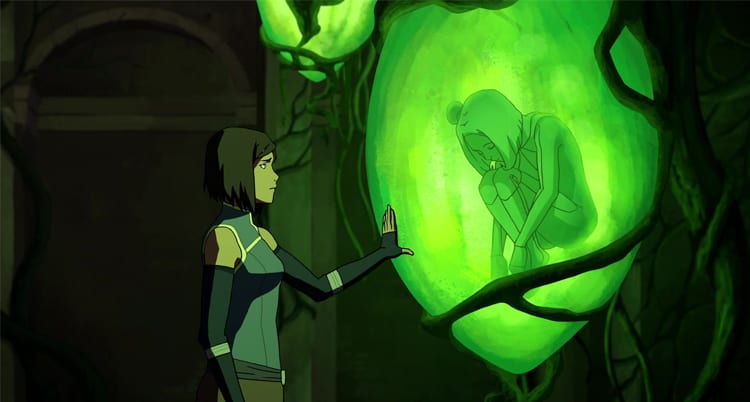
Small problem: it requires her meditating into the Spirit World, and when she tries, she once again flashes to Zaheer and dark!Korra. Korra decides she has to confront Zaheer in his prison, which she does alone. It’s clear she’s still scared of him, and we learn that the most frightening aspect to her is her having been completely out of control in their fight. Dark!Korra represents that extreme vulnerability to her. Despite their differences, Zaheer agrees to help guide Korra through meditation into the Spirit World, since he believes that Kuvira needs to be stopped too. Using language evocative of mindful meditation, he tells her to accept what happened to her.
She manages to let go and allow the upsetting flashes play out, despite being out of control. Once that happens, she finds herself in the Spirit World, where she reconnects with Raava (or rather, reestablishes their connection; Raava hadn’t gone anywhere), and saves the tourists. Turns out she can energybend in the Spirit World, demonstrating that she’s even more powerful than she had realized. She tells Mako that she finally feels “whole” again after this.
All that’s left is to save the world from a technocratic emperor then, right?
Korra does just that, but it’s clear that there’s been a shift in her mentality and approach to fighting. It’s not that she’s any less proactive or fearless—quite the contrary. However, there’s a strategy. When Kuvira invades Republic City, she knows they can’t take her on head-first, and instead devises a plan to kidnap her fiance Baatar Jr., thinking they could reason with or strongarm him instead. When it becomes apparent that he’s as committed to this plan as Kuvira, she shifts her tactics to target his love for Kuvira.
Korra: We’ve been going about his all wrong. You’re right. I’m not gonna physically hurt you if you don’t talk. But there is something I could do that will be even more painful. I will take away the one thing you care for the most…Kuvira.
Baatar Jr.: What do you mean?
Korra: Kuvira might win. She might chase us out of the city. But you won’t be around to enjoy the victory. Because wherever I run, I’ll take you. I am going to make it my life’s mission to never let you see the one you love again. Is taking the city worth losing Kuvira forever? (4×11)
This ultimately blows up in Korra’s face (kind of literally), when they find out that Kuvira is willing to sacrifice Baatar to accomplish her goals. Only then does Korra realize they have to take Kuvira head on. In this showdown, we see that Korra’s bending is about as powerful as it’s ever been. But that’s not what saves the day. Kuvira’s spirit vine super-weapon malfunctions, and when it’s about to accidentally fire on her, Korra throws herself in front of her enemy and bends the energy of its fire power to save her. This ends up ripping open a new spirit portal in the heart of Republic City, which she and Kuvira get blasted through.
Once in the Spirit World, Korra “wins” the fight by simply relating to Kuvira. She tells her that she understands acting from a place of vulnerability and worry, not knowing what will happen. Kuvira was trying to keep the people of her kingdom safe, just like Korra had tried to keep herself safe by cutting herself off and fighting the disturbing visions every step of the way.

Kuvira surrenders, realizing how out-of-balance she got, even if her intentions had been good. This hearkens back to Toph’s advice about Korra being able to learn something from her past enemies, and come to understand their views even if not agreeing with their means or ends. Korra can “carry around” her past battles in this sense—that there’s something of value there she learned, and can apply to other situations.
Later, Korra reflects on this to Tenzin. The meaning she found in her injury and recovery from Zaheer is that she can empathize better with people like Kuvira now, and she can’t regret going through that given her perspective now. This serves as the endcap to Katara’s advice as well. She’s reshaped the world possibly more than any other Avatar (at least since Wan), yet she tells Tenzin there’s more she wants to do, and she’s hopeful about the future. It’s clear she found an inner sense of peace.
The series then ends with Korra allowing herself a moment of self-care: she asks Asami to go on a vacation with her, quite obviously framed as a beginning to their relationship (and a very intense first date), and steps into the spirit portal with her as the last shot.
Korra’s Withdrawal, and Why Korrasami Still Sounds Perfect
There’s a lot to be said about this arc, as well as its implications—positive and negative. However, as we were talking through it, one of the things that jumped out to us was how female-driven this was. In fact, all of Korra’s primary dynamics in Book 4 were with other women. Katara and Toph both served in a mentor role, each delivering a neatly packaged thesis statement (Katara’s focused on Korra’s internal journey, with Toph’s focused on the main tensions of the season). Jinora was the first person Korra reached back out to in a very external way. Asami was the person Korra realized she was in love with and took steps into the future with her. Kuvira served as Korra’s antagonist and foil; Senna was the one who begged Korra to go visit with Katara in the first place; even Raava (in some ways a representation of Korra’s self, but still) is female-coded.
Korra’s final conversation with Tenzin was more a result of their dynamic in previous seasons (not that he’s chopped liver to her or anything), and frankly other than Zaheer, there wasn’t a man who particularly influenced her recovery. Not to mention his mindful meditation session was far more about Korra’s inner demons than him.
There’s not much to say about that pattern beyond, “Hey, neato,” but it’s worth noting that even over three years later, this is a major anomaly in modern media. And given Korra’s brutalization at the hands of specifically men for three books, a very welcome one for her. No more “Aang magically fixed her instantaneously.” She’s found balance and healing in and through relationships with female characters.
That brings us to the other “anomaly”: Korrasami.

Though wlw portrayal has come a lot in the past few years, it is still hardly commonplace. And it may be hard to remember, but in 2014, this representation had never existed before in Y7 programming. We’re talking pre-Rupphire on Steven Universe. Watching the final season, Korra ending up with Asami seemed like the most obvious thing in the world really—they were the closest emotionally, it was to her that Korra confided about her struggles with the Avatar State. With “The Earth Queen” and “Long Live the Queen” especially, Book 3 showed us how in tune Korra and Asami were on multiple levels, and despite the hurt feelings at their initial reunion in Book 4, we saw them immediately snap back into that productive dynamic.
However, years and years of storytelling conventions still made it seem like the longest of longshots. So, bemoan its reserve (Bryan certainly did), but in terms of the characters at play, it’s hard to argue there wasn’t a natural flow to that end point, which was in fact a new beginning.
We both have to applaud the way that Korra’s interest in Asami and their feelings for each other really didn’t become any sort of focal point. Too many healing arcs in shows are about the power of love (heck, Book 1 somewhat framed Korra’s airbending mastery as being linked to her feelings for Mako and endcapped her ‘healing’ with a kiss between them), and while that’s not strictly a bad thing since love is…nice (?)…we find it more refreshing and impactful that it was Korra’s own force of will and inner strength that guided her healing. It’s an uplifting message, that we all have this capacity to strive towards healing and reach a place of peace and balance on our own.
It’s not to say Korra’s loved ones didn’t influence her—of course they did. Reuniting with Jinora (her spiritual guide), Ikki, and Meelo gave Korra the resolve to bend the remaining metal out of her body. But her path to healing was focused on embracing her own vulnerabilities and uncertainties, and learning not carry them with her like tiny drops of metallic poison (it’s like it’s a metaphor or something!).
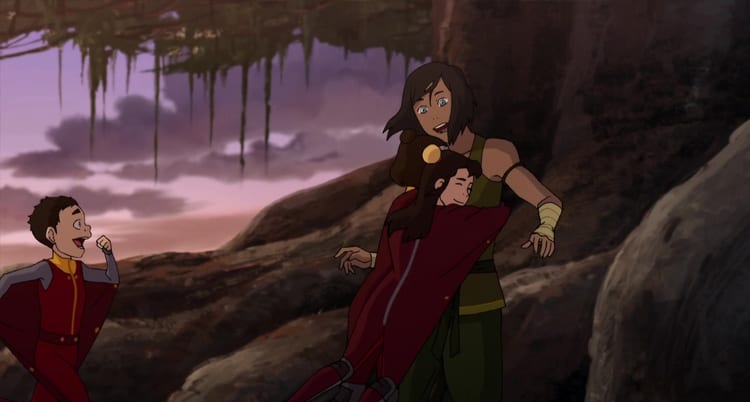
So then, why would we bring up Korrasami at all? Well, because that’s the end point for Korra in the series proper. This is the final note (or, musical cue) Bryke picked for her. As it aired, there had been criticism from some viewers that it was arbitrary, or tacked-on fanservice. But in our minds, it was the perfect way to resolve her healing arc, and the franchise as a whole.
Korra being disconnected for too long from the people that she loved was a rather apparent reason for why her progress had stagnated. When we meet Korra in Book 4, she may have the regained the use of her legs and her bending, but she’d lost a connection with almost everything else. She has a tenuous tie to Asami in the form of that one letter, but lost all sense of what Asami is doing, as well as the rest of her friends and family. She had no connection her her past lives or Raava. She had lost a sense of her own bending ability, too, in that she’d been living with self-imposed boundaries and didn’t trust herself to lean into or rely on her skills the way she used to. She was out of touch with Republic City and the world at large. She really was ‘alone’ in a way she’s never been before in her whole life.
And it’s understandable why she withdrew: she was feeling weak and vulnerable, and didn’t want to come back until she was ready to embrace her role again. This is why she had a mounting frustration when months passed without progress, and it’s certainly why she turned and ran, opting to hide herself instead, when she got feedback at that village that she wasn’t “fit” to be the Avatar. At least, in her mind.

To end on the note of beginning a new relationship with the woman she fell in love with over her three years away is a direct response to that. It’s not just demonstrating that she’s back and rekindled her friendships—we saw that explicitly. It’s that she is allowing herself to prioritize a relationship after everything she’s been through. That’s why the criticism of her somehow shirking her duties to have a vacation have always bothered us; if anyone’s earned a damn break, isn’t it her? Especially since putting too much pressure on herself to be this paragonal Avatar (that’s never actually existed) was what caused so much anxiety and stress to her in the first place?
Then there’s the fact that the show ends on a new beginning. I can understand the frustration of not seeing an explicit representation of this relationship on screen (i.e. a kiss), but at the same time, this is their first date. In some ways, the “incomplete” nature of that last shot without a kiss was kind of perfect, since the lack of finite resolve between Korra and Asami was the point, right? Their story isn’t done, it was just starting. But the series and franchise story was concluded. Korra, the first Avatar of the new age, found her place in the world, found her inner peace, and is now pursuing her own personal happiness. What we can imagine is more powerful than had anything that could have been shown to us.
We mean…we still would have liked a dang kiss. Come on now. But given the perceived restrictions on this medium, this is what we got. And it’s kind of perfect for that meta reason.
Heck, this isn’t even touching the out-of-verse transgressive nature of it perfectly mirroring Korra’s own in-verse transgressions. It’s impossible to separate Korra’s queerness, in the most literal sense of the word, from her healing arc, and from her staking a claim to her place in both the narrative and the world. Then we’ve got the rather remarkable foils between Korra and Asami that hammer home the theme of ~balance~ in an almost stupidly immaculate way.
As Kylie’s put it before:
“Korra represents ancient spiritual wisdom where Asami represents modern technological innovation. Korra (as the Avatar) is the champion of the downtrodden, where Asami is wealthy. Korra is sheltered where Asami is wordly. Korra bends every single element where her girlfriend bends none. There’s the way their strategization and fighting styles play off one another too: Korra is very “shoot first, aim second,” decisive, and at times hot-headed, while Asami is reserved, meticulous, and at times known to hide from her problems (see: not visiting her father for 3 years). Korra has a vision for the world, and Asami has the ability to bring it into the material, as was demonstrated by her infrastructure work that married the spirit vines and the modern city.”
Korra’s never, for even a single millisecond, depicted as incomplete without Asami, or without romantic love in her life in general. Hell, her moment of first connecting with herself to unlock her ultimate cosmic power (without any Avatar spirit in her, it’s worth noting), happened at exactly the same time she was reminded of her breakup with Mako that she had forgotten about prior thanks to amnesia. Obviously that didn’t affect a whole lot for her in that moment, even if she did have a sort of sad, resigned, “this isn’t working” moment with him later.
But ending on Korrasami showed that Korra was still moving towards healing, towards letting her guard down, towards leaning into her connections with others. And it’s just so dang perfect that it was with the one person who complements her so thoroughly.
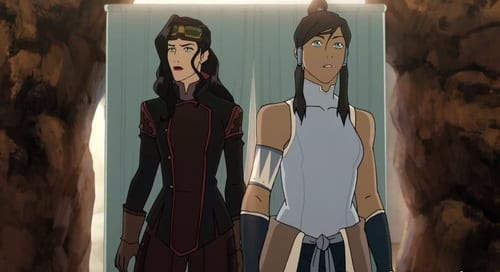
Korra’s Balanced Endgame
And that brings us back to the discussion of balance, which is what Book 4 (and arguably all of Legend of Korra, and even its precursor) is all about. As we mentioned, Korra’s healing brought her to a place where she was able to balance her duties as the Avatar with her personal life. She no longer felt guilty about taking time away, as she did when Book 4 opened, and she accepts that she doesn’t have to do it alone. She doesn’t have to save the world herself, as she has believed most of the series.
Kuvira acts as a foil to showcase her progress in all of this. Just as Korra had believed it was her sole responsibility to save the world, that same mentality is what got Kuvira to the point where she would willingly sacrifice her fiance to achieve her goals: the belief that she alone was responsible for saving the Earth kingdom from itself. Like Korra, Kuvira saw a need and wanted to fill it when others wouldn’t or couldn’t. Like Korra, Kuvira has a fierce desire and determination to protect her people; you only have to compare Kuvira to Korra’s Book 2 arc with the Southern Water Tribe.
Kuvira: We are nothing alike!
Korra: Yes, we are. We’re both fierce and determined to succeed, sometimes without thinking things through. (4×13)
And like Korra, Kuvira went too far and didn’t consider all the consequences of her actions and choices (though to be fair, Korra never came close to being a fascist dictator). Kuvira became fixated on her own skills and power. And on other people needing to acquiesce to her power and confidence.
Kuvira: This wasn’t how I wanted things to end. If you would have all just surrendered, none of this would have happened. (4×13)
Sounds a lot like Books 1-2 Korra, doesn’t she?
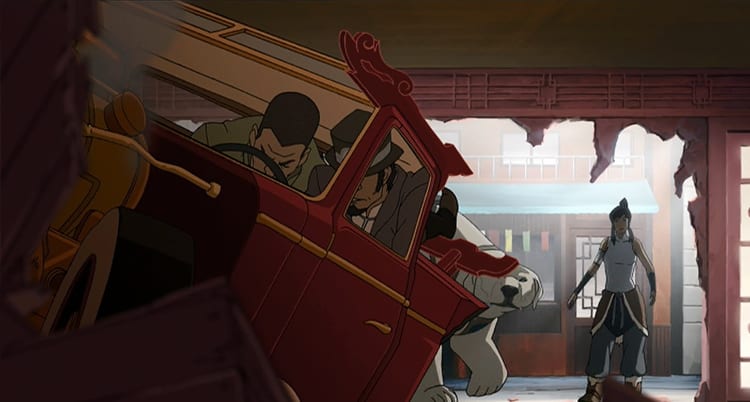
Yet even in her final balanced-state, Korra doesn’t lose what makes her unique. She’s still fierce and proactive—she jumped in front of a damn cannon to save Kuvira and made her stand at Republic City despite her initial desire to pursue a peaceful solution. But, there’s a contemplativeness to her, and she finds solutions to struggles not through flexing her physical prowess but by tapping into a shared vulnerability with her antagonist.
She’s less “I’m the Avatar and you gotta deal with it,” and more “I’m the Avatar, and I get to decide what that means for me.” Her being the Avatar isn’t about other people acknowledging her power or position, as it was for much of her story. There are layers to her self-conceptualization now. Being the Avatar does still include a sense that other people acknowledge her power, but now it’s disarming rather than aggressive.
She’s also someone who leads with compassion more than she used to. Not that she was ever non-empathetic…we see her sympathize with Tarrlok of all people way back in Book 1. Rather, she takes a more thoughtful approach to dealing with complicated issues in the final season, trying to see other people’s perspectives before deciding on a course of action. Or in the case of Baatar, switching her course of action based on her perception of that perspective. Her power lies not just in asserting physical strength, but through taking a more multifaceted approach to problem solving. She’s come to a place where her stance is less “you have to listen to me because of who I am” and more “because of who I am, I will listen to and understand you first.”

And, as we keep pointing out, she’s found a way to carry her struggles and the lessons she’s learned from them with her as wisdom. She ‘defeats’ Kuvira through expressing empathy, validation, and vulnerability. She sees Kuvira, relates to her, and pinpoints how Kuvira was out of balance, just as she herself had been. She has internalized Toph’s lesson about seeing her enemies for their extremism, not just their antagonism to her, and molded that into a means of finding an ultimately peaceful solution. That’s balance.
The Representation of PTSD
Through all of this character work, Legend of Korra never lost sight of its chosen narrative of representing PTSD. As someone with PTSD, Gretchen is continually blown away with how sensitively Book 4 explores Korra’s trauma. Not a lot of stories she’s engaged with have come close to this level of thoughtfulness, and it’s a kid’s show. (Steven Universe, The Hunger Games, and Jessica Jones are other pieces of media that spring to mind when it comes to nuanced depictions of PTSD.) It would have been so easy for Bryke to shortcut Korra’s healing at multiple points throughout Book 4, but they didn’t. For the length of the season and age group this show was written for, it’s damn fantastic. It’s Y7 appropriate, yet it still demonstrated that healing isn’t linear or easy.
There were layers to her trauma, and layers to her healing. Korra wasn’t just physically poisoned, her trauma had emotional, spiritual, and mental aspects to it as well, as is true of PTSD in real life. The emotional layers manifest in her ongoing depression, fear, and the repeated emotional memories/flashbacks Korra experiences. Their suddenness, unpredictability, and lingering effects rung especially true for Gretchen.
Korra struggles with mental blocks, lacking faith in herself and her abilities and feeling like she can’t trust herself or her perceptions. Yet another true-to-life representation of the experience of PTSD. Korra also wrestles with competing desires regarding how other people treat her. She doesn’t want people to walk on eggshells or treat her as incompetent or damaged—that feels like an admission of failure and weakness when she’s desperately trying to heal and be strong. At the same time, she wants space to be vulnerable if she needs to be.
The push-pull of “I’m not weak” and “Let me be weak” seems contradictory, but it precisely encapsulates the struggles of someone living with PTSD. It’s all about timing, self-confidence, and believing that other people trust you to manage yourself unless you ask for help. “I can do this unless I ask for help, so please don’t treat me like I can’t unless I’ve asked you to help me.” The accuracy is heart-wrenchingly moving.

Korra’s spiritual trauma manifests in her loss of connection from Raava. Insofar as Raava is basically Korra’s “Avatar soul,” losing that connection is a significant loss to her own spirituality, something she’s struggled to connect with anyway and only recently had torn out of her and restored. Small wonder she goes on a quest to find that piece of herself again and reconnect with it. Loss of spiritual connection is quite common in the aftermath of trauma, and even though it wasn’t the focus of Korra’s healing, that they bothered to include her spiritual side at all speaks volumes for the degree of thought that went into this.
That they let Korra confront Zaheer is significant as well. Bryke created space for Korra to confront the person whose actions haunted her most; she got to say exactly what he did that hurt her and how it has impacted her life, and without any justification from Zaheer. She gets her say, and that’s that.
But they don’t even end it on that event, which would have been yet another reasonable place to ‘end’ her healing arc. Instead, Korra literally faces her trauma in what is basically a word for word transcript of what a safe guided meditation looks like from a licensed professional:
Zaheer: Focus on the sound of my voice. [Korra flashes back to her fight with Zaheer and him suffocating her] Let it play out.
Korra: I can’t!
Zaheer: You can. Accept what happened to you. Don’t fear what might have been.
Korra: I have no control!
Zaheer: Don’t be afraid. Hold on! (4×09)
In an ideal world, Korra would be doing this kind of work with a therapist, not the one who attacked her, but we’ll set that aside for now to talk about the important pieces of therapeutic work embedded in this seemingly straightforward exchange.
Everything about that scene rings true to Gretchen’s experience with exposure therapy and guided meditations through traumatic experiences. Zaheer encourages her to let the scene play out and not focus on her fear of what might have happened. Embedded in there is an admonition to focus on what did happen: Korra survived and is in the process of healing. She is safe now, and that is underscored in her re-experiencing that traumatic flashback. She grounds herself in the present (Zaheer’s voice, her own safety, the truth of what happened rather than her fear) while re-living the past and that is what robs the traumatic memory of its power over her.
Zaheer also grounds and re-centers Korra by repeating to her that she can face this, she can accept it, and she can control it. She’s not as powerless as she feels and is capable of facing this down. The power to do it comes from within herself, but she needed a guide to remind her at every step that she’s capable.

There are echoes of Korra’s previous traumas as well. Her weakened abilities and the loss of the Avatar state echo Book 1 (and Aang’s trauma in Avatar: The Last Airbender). Her loss of connection to Raava echoes Book 2. Korra even flashes back to previous villains and Toph explicitly draws a line between all of Korra’s traumas when she talks about Korra carrying around the metal past trauma in her body.
Bryke basically created space in Book 4 to deal with all of Korra’s past traumas in a nuanced way after having neglected them for three books. Korra processes her struggles with controlling and trusting her bending in a way that rings true to what should have happened after Book 1. She goes on a spiritual quest to reunite with Raava and finds a way to connect even more deeply with her Avatar Spirit and other aspects of her spiritual nature, as she should have done after Book 3. And all that while dealing with her physical limitations and pain (the poison), the flashbacks and emotional aftermath of almost dying, and reconnecting with her friends, family, and the world. That’s a hell of a lot to pack into 13 episodes, and you know what? They did it really well.
Most importantly to Gretchen’s mind, given her experience with PTSD, was the explicit focus on acceptance.
Mako: Do you think you’re finally able to forget what Zaheer did to you?
Korra: No. But I am finally able to accept what happened, and I think that’s gonna make me stronger. (4×09)
Healing isn’t about forgetting; “forgive and forget” is bullshit (take note, Asami). A good therapist will tell you that healing is about acceptance. In certain therapies, they call it radical acceptance, and it doesn’t mean that what happened was good or that it wasn’t painful, awful, and traumatic. Acceptance just means stating the truth of the event as a fact and no longer focusing on wishing it didn’t happen. Korra will never forget what happened to her, but she doesn’t have to carry the fear, pain, or anxiety about it forever. She can accept that it did happen, and not let it control her.
Korra reaches that place of peaceful, calm acceptance after confronting Zaheer and facing her trauma head on, letting it play out through mindful meditation, and letting it guide her into the Spirit World. Only after she’s faced and accepted the truth can she fully reconnect with her spiritual self and the world of the spirits. Acceptance leads to reconnection, which becomes a source of strength, balance, and compassion.
“…That came out wrong”
That’s not to say things were 100% perfect with Korra’s arc in Book 4. Even our little joke about Asami just now does have some weight behind it: doesn’t her quick forgiveness of Hiroshi kind of seem counter to how Korra approached Zaheer? Both these guys had tried to kill them, respectively.
There’s also that Korra and Kuvira did have to have an intense physical fight before Korra found the more balanced, strategic approach to get her to give up. But given the stakes of the invasion, not to mention the genre of the show, we don’t take any particular issue with this. In fact, we loved seeing Korra’s resolve and commitment to engage in a situation that was, for once, not coming from a place of anxiety, fear, or overcompensation.
Still, the biggest misstep of this portrayal is a criticism that largely was raised by women of color within the fandom. It stems from the wording of Korra reflecting on her trauma to Tenzin.
“I know I was in a pretty dark place after I was poisoned. But I finally understand why I had to go through all that. I needed to understand what true suffering was so I could be more compassionate to others, even to people like Kuvira.” (4×13)
As we talked about before, this relates back to Korra finding a meaning in her suffering, like Katara talked about Aang doing. And with the benefit of creator interviews, Bryke spoke about their influence in writing this on the Book 4 DVD commentaries (as well as podcasts). They said they had read a memoir of a war journalist who had been shot, and he chose to recontextualize his own trauma to give meaning to it, viewing it as having been necessary to understand what all the people living in these countries were going through.
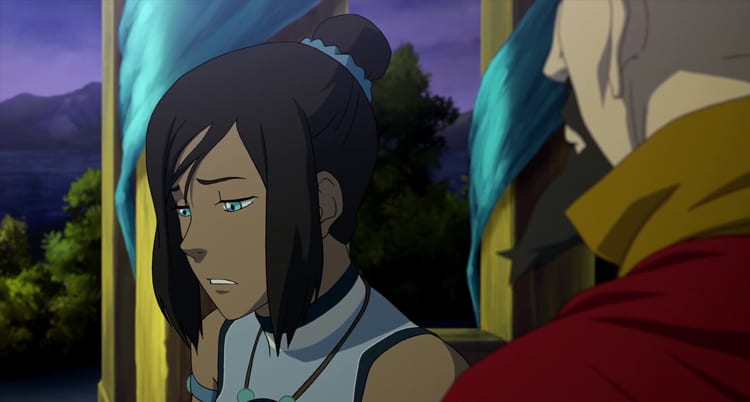
We talk a lot about misaligned intent and result, and how sometimes there is a space to award effort. Here, we think it’s important to recognize that Bryke did have good intentions to write a true-to-life healing arc with an uplifting message. That story is powerful. And that method of coping with trauma—recontextualization—is certainly not something limited to white men.
However, there’s a reason intersectional approaches to feminism are important. You can’t just copy-paste the experiences and takeaways of one person and put them into the mouth of a wildly different character without some forethought. Had Aang (who is decidedly not white, it should be noted) said a line like that, it would have felt different than having it come from Korra, an indigenous, brown, bisexual, mentally ill woman. There’s common tropes and conventions, and sadly in our media’s history, that includes the brutalization of women to ‘learn’ respect, particularly women of color. Korra’s cultural background may not have lead to any kind of in-verse prejudice, but viewers watch the show in today’s cultural context, and for many, it was hurtful to see Korra implying that she needed to suffer to get to that place where she could chuck herself in front of the cannon to protect Kuvira, or find that commonality in the Spirit World.
We can split this down however we want, point out that it was about needing to understand suffering rather than the actual suffering itself, and so on. To us, the good intentions are clear, and what Bryke was going through is fully accessible. But again, that doesn’t mean there’s not a very valid discomfort with two white men using Korra as the mouthpiece to that message. Especially when the same message could have been explicated without the “why I had to go through all that” part.
Had there been a more diverse writers’ room, had there been a more diverse vocal cast, had research been done about individuals with PTSD of different backgrounds and intersections…maybe that line looks different. It’s okay for something to be both validating and offensive, depending on engagement; sometimes, that those feelings even overlap.
What’s important is listening to each other and striving for more and more authentic and representative media. On that front, we find it hard to argue that Legend of Korra wasn’t a constructive TV show overall.
The Last Avatar
We think a large reason why Legend of Korra was so constructive had to do with Korra being a deconstruction of her predecessor, Aang, in the first place. She was the over-eager woman rejected by the world, instead of the reluctant male hero needed by the world. In the end, they were both loved and praised and counted on, but for her, that required her quite literally reshaping the world to find her place within it.
This is why the focus on her vulnerability as a strength, and her pursuit of balance is so crucial. Because it’s not just the end of her story, but the planned end of the franchise. Aang’s story was very much also about balance and vulnerability, and his resistance to killing the Fire Lord resulting in him breaking the rules of the universe a little to find a path that worked for him. They both went through journeys of “self-discovery” in this sense, but given Korra’s in and out-of-verse intersectionality, that she was put through the wringer as much as she was is both poignant and uncomfortable.
At the same time, it makes seeing her so effective, so strategic, and so inspired all the more impactful. Her boldness and determination to succeed is absolutely still there; she rejected Raiko surrendering the city, for instance, and not only was willing to sacrifice herself for Kuvira of all people, but was willing to sacrifice herself in the Avatar state, meaning she was willing to end the Avatar line to save her antagonist. That’s dang powerful, and no wonder Kuvira was humbled by it.
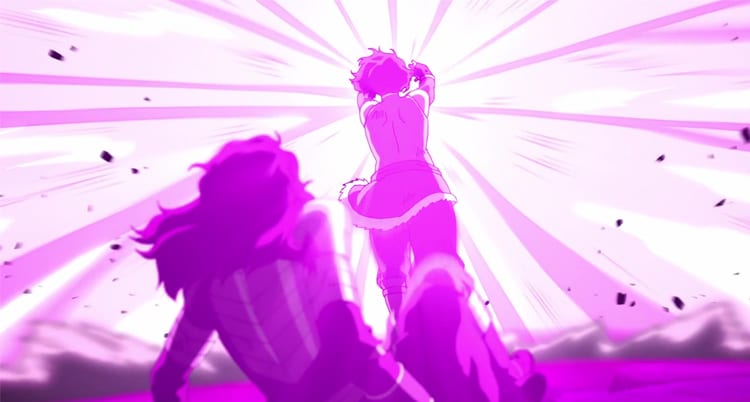
Yet it’s her quieter determination in both the Spirit World and in her conversation with Tenzin that stand out even more, and demonstrate how far she’s come. She’s grown up a ton from the girl who challenged Amon to a duel out of fear of seeming weak. And while she absolutely didn’t “need” to go through the hell that she did—no one does—that she got to a place as a character to have a positive takeaway and hopefulness about the future is the true power of this narrative. It’s aspirational, sure, but a reminder that we’re all allowed to be broken. We’re allowed to find our own meaning in our suffering that makes sense to us. And, we’re all allowed to self-care.
This is why it’s just such a dang perfect thematic and character end-cap.
That’s also why we opened this article talking about the Turf Wars comics. It’s not that we can’t imagine a story following this one; there’s certainly still things to explore with Korra, like how she continues to define her role as Avatar now that there’s no need for a bridge between the Spirit and physical worlds. Heck, we’re not even saying she couldn’t continue to process her trauma. She may have gotten to a place of accepting it, but in our experience that’s less of an endpoint, and more of a frame-of-mind that can be an ongoing struggle to maintain. But in the case of the comics we’re getting, it’s really hard for us to go from this wholly satisfying character endpoint into something where Korra seems far less at peace and far more like her pre-healing arc self.
Truthfully, even if we had been given comics with a Korra in her finale headspace, we think it would have been an uphill battle for us to be as enthused with it as we were with the ending of the series. Because let’s be real: what could top that? We don’t think there needs to be an answer, at the end of the day. There’s a reason Legend of Korra has stayed with us as long as it has, and of course we’ll support any material that keeps us in this universe. But if the worst thing is that our praises peaked at the franchise’s TV ending? Well…sounds perfect to us.

